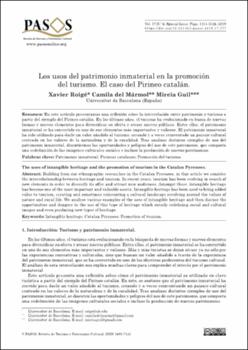Los usos del patrimonio inmaterial en la promoción del turismo. El caso del Pirineo catalán
Fecha
2019Resumen
En este artículo presentamos una reflexión sobre la interrelación entre patrimonio y turismo a partir del ejemplo del Pirineo catalán. En los últimos años, el turismo ha evolucionado en busca de nuevas formas y nuevos elementos para diversificar su oferta y atraer nuevos públicos. Entre ellos, el patrimonio inmaterial se ha convertido en uno de sus elementos más importantes y valiosos. El patrimonio inmaterial ha sido utilizado para darle un valor añadido al turismo, creando y a veces reinventado un paisaje cultural centrado en los valores de la naturaleza y de la ruralidad. Tras analizar distintos ejemplos de uso del patrimonio inmaterial, discutiremos las oportunidades y peligros del uso de este patrimonio, que comporta una redefinición de las imágenes culturales sociales e incluso la producción de nuevos patrimonios. Building from our ethnographic researches in the Catalan Pyrenees, in this article we consider the interrelationship between heritage and tourism. In recent years, tourism has been evolving in search of new elements in order to diversify its offer and attract new audiences. Amongst these, intangible heritage has become one of the most important and valuable assets. Intangible heritage has been used to bring added value to tourism, creating and sometimes reinventing a cultural landscape revolving around the values of nature and rural life. We analyse various examples of the uses of intangible heritage and then discuss the opportunities and dangers in the use of this type of heritage which entails redefining social and cultural images and even producing new types of heritage





